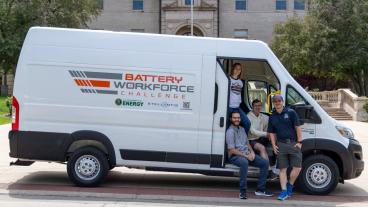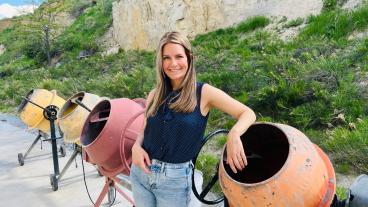This article is part of a series on the undergraduate research fellowship program
Engineering physics junior Steven Hackenburg is working with physics professor Dr. Lawrence Wiencke on programming that remotely controls the laser systems at the Pierre Auger Observatory, located in Argentina. Hackenburg studies cosmic rays, high-energy particles, mainly originating outside the Solar System, as part of his undergraduate research fellowship.
“Relatively speaking, we understand light and its properties quite well, and we use it to learn about the universe, from confirming Einstein’s theories concerning gravity, to discovering the composition of planets,” Hackenburg said. “On the other hand however we know little about cosmic rays compared to our understanding of light.”
Hackenburg fires laser shots into the sky in directions where potential sources of cosmic rays are believed to exist. He uses the fluorescence detector to study the tracks in the sky created from the laser. The data from the laser tracks are used to verify that the fluorescence detector is measuring the directions of the rare cosmic ray tracks properly.
Hackenburg said he has always been interested in the mysteries of space and the universe.
“It's amazing for me to think about how little of the universe we have been able to explore in any depth compared to the size of the universe or even our own galaxy,” Hackenburg said. “Also, think about how we get the information about the universe; we observe it. We, as scientists, look to the stars for answers.”
In early 2013, research analyzing data from Fermi revealed that supernovae were a source of cosmic rays. However, supernovae do not produce all cosmic rays, and the proportion of cosmic rays that they do produce is a question which cannot be answered without further study.
“The sources of these particles remain an important question, coming from somewhere outside our galaxy. They are very rare,” Wiencke said. “At the highest energies (10^20 eV), the flux is something less than one square mile per century.”
Weincke and Hackenburg generate many tracks with the laser systems every night of operation.
“This data is used to demonstrate that the observatory is working properly and ready for the monster cosmic events when they occur,” Wiencke said.
Applied physics graduate student Carlos Medina helped with the construction, system integration and testing of the Central Raman Laser Facility in Argentina. He collects data from the CRLF that he is analyzing for his PHD thesis in astrophysics.
“I am happy to have the opportunity to study and analyze data that will help us better understand our universe,” Medina said.
Undergraduate research fellowships are administered by the research council. Students can apply for a fellowship to work on a project with a faculty member.
Contact:
Kathleen Morton, Communications Coordinator / 303-273-3088 / KMorton@mines.edu
Karen Gilbert, Director of Public Relations / 303-273-3541 / KGilbert@mines.edu



